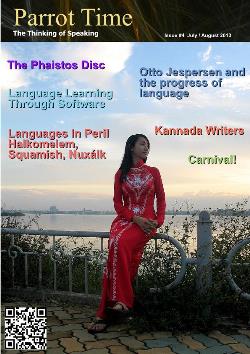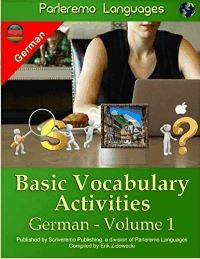
|
With the explosion of the computer scene in the past few decades, allowing for people to have computers on their desks, on their laps, and even in their pockets, computer software is now available for just about anything. Naturally, then, there is software available to help learn languages. Language software varies greatly in the approach to learning. Some are basic game and drill programs, while others include more developed methods through reading and listening. Prices also range from the relatively cheap to the very expensive. We are going to look at a few of the popular software programs, their approach, and how beneficial (or not) they are. Rosetta Stone We might as well start with one of the most talked about software programs, Rosetta Stone. It attempts to teach languages through the concept of "learn like a child learns". This means, in this case, using word and phrase associations to pictures. The setup is simple. A user is given a word or phrase in the target language. Underneath that are four pictures. The user must select which picture best fits the given word or phrase. Once they have selected the proper one, the word or phrase changes, as does the order of the images, and the user guesses again. This continues until all four of the images have been matched, then a new set of images is used. Through this process, a person should be learning the language subconsciously while matching images, like a child learns by associating words to objects around it. The entire process depends on repeition, so the student will need to be working through a large number of these images before they really retain much. 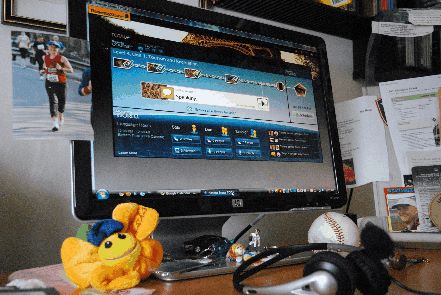 Computer running Rosetta Stone TOTALe The process has a sense of fun because the learner is getting a direct sense of accomplishment as they click on the images. This is probably the main reason that so many people like Rosetta Stone... because of this feeling of accomplishment. There are a few problems with this process, however. First of all, it is a false sense of accomplishment. Since the user has multiple choice of four items, and each image is used just once in a batch, then as long as the user doesn't select an image twice, the chance of getting it correct increases each time. For example, when the user sees four images, they have a one-in-four chance of selecting the correct match for the first phrase. After that, with all the same images being presented again, the user knows that the one they chose previously will NOT be the answer to the second phrase, so they have just three images to select from, a one-in-three chance. After that, they have just two to select from, then lastly, they can't get the fourth one wrong. It would be a more fair assessment of their progress if every new word or phrase had four completely new images, rather than using a group of four. The second problem is variety and expanse. The images will often display things like a number of colored balls or people doing things. Once a person has, from these, learned some basic colors like red, blue and green, they would then need to go through many other images to learn orange, yellow, brown, black, white, purple, etc. This might not be a problem if the series of phrases focused on colors, but it can take a very long time if these are being done along with, say, learning numbers. With respect to numbers, the pictures might be able to teach a few numbers, perhaps from one to ten, but how does one teach larger numbers, like thirty, or one hundred, using just images? This could only be done by switching back to just vocabulary and numeric pictures (the picture consisting of just the numerals). Similar problems with people. While the user might start getting down concepts like "boy", "girl", "man" and "woman", what about relationships of those people? Does that image of a boy mean "boy", "brother" or "son"? Is that a "woman", "wife", "sister", "aunt" or "mother"? We took a long time as children to learn those differences, and they were explained to us. No explanation will be coming from just a set of pictures. That last point highlights a major drawback to learning by just visual references in general. If someone holds up a plate of hot spaghetti and points to it, saying "grond", how do we know what "grond" refers to? The plate? The food on the plate? The temperature of the food? The color of the food? The kind of meal it is, such as breakfast, lunch, or supper? 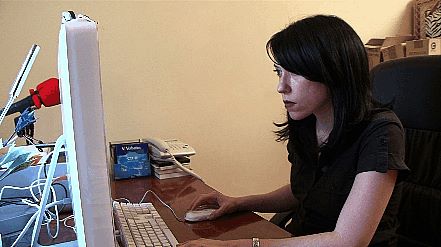 Woman using computer to learn Another problem with image learnig is how to represent more abstract concepts. Show me a picture of "want". How about "think"? You can think of something that might represent those, like a child reaching for something, or a man looking off into space, but there is no way to make sure the learner is getting the real meaning. Lastly, how do you represent action, especially in different tenses? If there is a child with a book, you could say "The boy is reading the book". But how do you say "The boy will read the book" or "The boy read the book"? Oddly enough, a commercial for Rosetta Stone uses a testament to how useful the program is by giving an example that wouldn't happen. A woman claims that now her granddaughter can say "Te amo, tita!", which is (debatedly) Spanish for "I love you, grandmother!". That is a phrase that could never be properly displayed in an image. The best that could be given is a child hugging an older woman, but that could be interpreted in several ways, with "I love you, grandmother!" being the least likely. The silliness of the example also makes one question why the woman (or granddaughter) would need to learn all of Spanish in order to say that. If the granddaughter is saying it to the grandmother who speaks Spanish, then the grandmother certainly doesn't need to use Rosetta Stone. And I am hoping she didn't put her granddaughter through endless repetition to learn a single phrase. 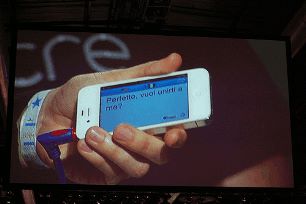 Software for language learning can be used on many devices now, even phones Now, in fairness, the idea of using multiple choice, images, and repetition isn't bad. Vocabulary is often practised using such methods, as we will talk more of later. The problem here is that you can't use that method to learn a whole language. At best you can learn basic words. Advanced vocabulary, like abstract concepts, verb tenses and large numbers, will be ignored. Grammar rules will also be ignored. Rosetta Stone has also added some new aspects to their software. One is voice recognition. By setting certain things, like speaking level and age range, a student can speak to the computer and have it compare the sounds to a native speaker. The student must get the software to recognize what they are saying to be granted points for that section. This sounds very innovative, allowing not just a comparison to a sound but having the computer analyze it and scoring it. Unfortunately, this aspect of the program seems to have some flaws, and many people have complained that it won't recognize anything they say, even when they are native speakers. This represents a problem with having a machine attempting to understand human speech. Rosetta Stone Studio allows the student to have lessons with teachers through the software. The lessons are limited to fifty minutes and focus on specific ideas or vocabulary, like a normal lesson should. These lessons need to be done during specific time slots, so you can't just do them at your own convenience, which is similar to taking a class. However, having a lesson with a real person over a distance using a computer is really another form of class, learning through the software (the connection) and not really learning by the software. |
| Language Learning Methods - Software | ||||||||||
| Writer: | Erik Zidowecki | |||||||||
| Images: | ||||||||||
| ||||||||||
All images are Copyright - CC BY-SA (Creative Commons Share Alike) by their respective owners, except for Petey, which is Public Domain (PD) or unless otherwise noted.
comments powered by Disqus












